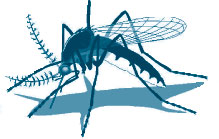Information on West Nile Virus

The Relationship Between Birds and Infected Mosquitoes1
The West Nile Virus is spread to people by the bite of an infected mosquito. The principal transmitter of West Nile Virus (WNV) is the Northern House Mosquito (
Culex pipiens). Mosquitoes first become exposed to the virus when they feed on birds that are infected with WNV. Once the mosquito is infected, it may transmit the virus to people or other animals when it bites them. Many birds can be infected with WNV, but crows and blue jays are most likely to die from the infection. Horses, too, are prone to severe WNV infection. People cannot get WNV from another person or horse that has the disease.
Should wetlands be drained to control mosquitoes?
Because the Culex mosquito can breed in very small amounts of water, eliminating temporary standing water in plastic containers, discarded tires, or other water-holding containers around one's property can greatly reduce breeding areas. Any stagnant water in rain barrels, irrigation ditches, clogged gutters, backyard home septic systems, and road-side ditches can serve as breeding sites. The difference between these water-holding places and wetlands is the presence of mosquito-eating predators. Wetlands are home to a host of mosquito-eating beetles, backswimmers, water striders, dragonfly larvae, etc. making them significantly less ideal breeding sites for Culex mosquitoes.
Even after "draining," a wetland may hold water from flooding, rainfall, or snowmelt. These low spots may produce more mosquitoes than healthy wetlands. In addition, filling these wetlands may force water to flow elsewhere, creating flooding or additional wetlands.
Of the forty species of mosquitoes that transmit the virus, three species have been implicated as the most common vectors.2 These mosquitoes are rarely found in healthy wetlands. In healthy wetlands water fluctuates regularly, which deters these three virus-carrying mosquitoes species.
Research from North Dakota found that there were many more mosquitoes in degraded wetlands than in higher quality wetlands.3The authors conclude that maintaining the natural functions of wetlands (i.e., minimize disturbance) would be a good start to potentially reducing mosquito habitat. The preservation of healthy wetlands, unpolluted by excessive urban storm water runoff and/or sedimentation should therefore be of vital concern to the public and to mosquito control agencies.
1 Wetlands and West Nile Virus ? Ohio State University Fact Sheet West Nile Workgroup http://ohioline.osu.edu/wnv-fact/1008.html
2 What Hunters Need to Know about the West Nile Virus - Ducks Unlimited
http://www.ducks.org/news/west_nile_virus_september_2002.asp
3 West Nile Virus Wetlands and Waterways - Oregon Division of State Lands http://www.dfw.state.or.us/wildlife/diseases/westnile/
S. Chipps, D. Hubbard, K. Werlin, N. Haugerud, K. Powell. December 2002. Development and Application of Biomonitoring Indicators For Floodplain Wetlands of the Upper Missouri river Basin, North Dakota. South Dakota State University.
Other West Nile Virus Links